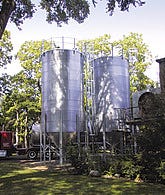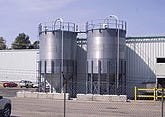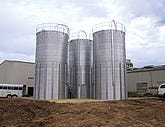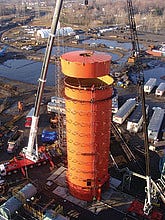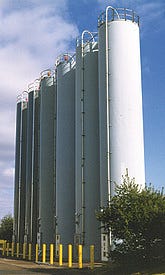February 8, 2011
By Chad Albert and Lori Nickel, The Eagle Group Ltd.
|
Two industrial corrugated galvanized steel silos at a facility in Saranac, MI |
Two questions that arise most often from customers seeking bulk material storage systems are: “What are the differences between available systems?” and “Is one system better than the other?” This article will address these items as they relate to some systems currently available on the market. Note that the list of systems described herein is not exhaustive as to all conceivable systems possible to bulk material storage demands. First, some available storage systems will be presented and then these questions addressed. The storage systems discussed here include corrugated silos, smooth-wall bolted silos, field-welded silos, welded silos, and horizontal storage vessels.
Corrugated Galvanized Steel Industrial Silo
Customers generally consider corrugated silos to be grain silos commonly seen on agricultural facilities. Industrial corrugated silos and grain corrugated silos are almost identical except for two features. The commonality between the grain and industrial corrugated silos is that they use the same prefabricated shell and structural components, of the same steel gauge, and galvanized finish. These base components and fasteners are shipped un-assembled to the jobsite for on-site assembly and erection. Seams between corrugated panels are bolted together with bolts encapsulated by polypropylene with neoprene gaskets between panels. No welding is necessary for a standard silo system of this type.
|
Corrugated galvanized steel tanks after years |
Corrugated silos generally have a galvanized finish without the option to paint them a specific color. The reflective finish tarnishes over time (with rate of deterioration dependent on environment) and settles into a flat gray. It is not common to have a corrugated system manufactured out of aluminum, stainless steel, or another material other than the carbon steel with galvanized finish.
Industrial and grain silos vary in the roof design and discharge ring size at the bottom of the hopper. Industrial silos generally have a more acute roof angle at approximately 10° from horizontal, whereas grain silos generally have a less acute roof angle at 30° angle from horizontal. This 10° industrial roof angle lends itself more to operator egress for maintenance as necessary. The 30° grain silo is based on optimization of storage volume where the roof angle parallels the mean angle of repose of the material to be housed. The 10° option generally costs more because it is not self-supporting and requires reinforcement. The discharge ring size is based on the variance of industrial materials versus that of cash crops based on the experience of the silo manufacturer.
|
Three skirted corrugated galvanized silos at a site in Frankfort, KY |
Advantages of this system are that all the components are mass produced and finished in a controlled environment, which results in reduced investment into the storage vessel’s material cost. Shipping costs are also reduced as all the components can be condensed into stacked panels. Welded silos could be 12 ft in diameter by 60 ft tall requiring permits for transit. However, corrugated systems also require more time in the field associated with erection and assembly of the panels together in an uncontrolled environment.
These systems are designed to handle dry materials having a unit weight up to 100 lb/cu ft. Each silo is designed according to ASCE code to withstand seismic, wind, and snow loads. Standard hoppers angles range from 45° to 60° from horizontal with nominal shell diameters from 9 to 24 ft. Supporting structure for the vessel can be legged or skirted with skirts being offered in diameters up to 15 ft.
|
Smooth-wall bolted tanks on customer site allowed this customer to add additional storage capacity at a later date without having to excavate more land. |
Smooth-Wall Bolted Silos
Smooth-wall bolted silos are similar to corrugated systems in that their components are pre-fabricated and finished in a controlled environment, and sent to the site for assembly and erection. These tanks have the capacity to contain both dry and fluid-based materials. These systems are based on components that are mass produced and finished in a controlled environment, which results in reduced investment into the storage vessel’s material cost. Unlike the corrugated systems, smooth-wall bolted panels can be manufactured in carbon steel, stainless steel, or aluminum with custom finishes applied to the carbon steel panels (epoxy, enamel, or another).
Shipping costs are also reduced as all the components can be condensed into stacked panels. However, they require skilled labor for assembly and erection. These systems have a greater probability of failure (leaking) than a field-welded or welded silo system as there are more bolted joints with gaskets (more potential points of failure). If a leak does develop with a welded silo it is relatively simple to repair the affected area with a new weld. However, to repair a leak on a smooth-wall bolted tank system is much more complex. Of the presented systems, these also generally take the longest amount of time to assemble and erect.
Advantages of this tank is that its unique design affords the design flexibility of replacing specific panels as necessary to add manholes, nozzles, or other fixtures. This system also affords the option of future expansion with the addition of body rings above the initial construction. Note that in order for future expansion to be feasible, the foundation and supporting structure need to be designed based on this consideration. Hopper configurations can be designed per the customer’s specifications. These systems can be supported by a traditional concrete slab foundation system or supporting sub-structure. The silo systems can be arranged to discharge directly into fifth-wheel (semi-tractor trailer) transportation vehicles with drive through systems in the supporting skirt or substructure.
|
Erection of a smooth-wall bolted silo at a coal energy plant in NY |
Field-Welded Storage Tanks
Field-welded systems are similar to smooth-wall bolted systems in that their components are pre-fabricated in a controlled environment and sent to the site for assembly and erection. Finishing the components in a controlled environment is available, with a masked-off edge to facilitate welding in the field. Once the field welding has been completed it needs to be finished in place to negate excessive corrosion at the joints. These components can also be shipped to the site unfinished and then finished in the field (in an environment). Systems are not based on mass produced components and are generally not finished in a controlled environment, which results in increased investment into the storage vessel’s material cost compared to corrugated or smooth-wall bolted systems. Like smooth-wall bolted system these silos can be manufactured in carbon or stainless steel with custom finishes applied to the carbon steel panels (epoxy, enamel, or another). An added advantage over corrugated and smooth-wall bolted is that they can be custom designed with relative ease.
These custom-designed systems are generally for large capacity system with vessel diameters of 16 ft or greater. Tanks have the capacity to contain both dry and fluid-based materials. Advantage of these systems is that capacity increases exponentially as diameter increases whereas capacity increases linearly with increased height, resulting in bigger economic gains in these larger diameter systems than the others presented herein. Shipping costs are average compared to the systems presented. Erection time and cost is the disadvantage because of the requirement of various cranes and lifts to complete the erection.
|
Six welded silos with safety bumper posts provide a storage system for a customer in Plant City, FL |
Welded Silos
Welded systems are similar to field-welded systems in that all the joints are welded and their components are pre-fabricated in a controlled environment. The welded silo is also assembled and finished in a controlled environment. Systems are not based on mass produced components (custom designed only) which results in increased investment into the storage vessel’s material cost compared to corrugated or smooth-wall bolted systems. Like smooth-wall bolted systems, these silos can be manufactured in carbon steel, stainless steel, or aluminum, with custom finishes applied to the carbon steel panels (epoxy, enamel, or another). An added advantage that these systems have is that they can be supported by skirted, legs, or substructure. The interior can also be finished with FDA-approved liners.
These custom-designed systems are generally for smaller diameters for material unit weights up to 150 lb/cu ft, compared to field-welded systems at less than 16 ft in diameter. Tanks have the capacity to contain both dry and fluid-based materials. Shipping costs are high compared to the systems presented as permitting is likely required. Erection time and cost is relatively low as the welded silo is a finished product when it arrives on site ready for installation. The installation should be able to be completed at a rate of one or two tanks per day with all standard accessories.
|
This portable storage unit on site in Ontario, Canada, allowed the user to comply with industrial park regulation and height restrictions and maintain a large material inventory. |
Horizontal Storage Vessel
A relatively new system for bulk storage is portable bulk storage bins that are available in a range of sizes. Capacities range from 10,000 to 60,000 lb, based on 35 lb/cu ft material unit weight. These units are designed to be placed inside a facility, outside in the parking lot, or on a pad, and can be manufactured to be stackable. Three hopper bottoms are at 45° from horizontal, with a typical 10° roof angle and a 20-in. man-way vent combination. Ladders installed on the outside makes for easy roof access. Units ship for ready hookup to conveying systems at a minimal cost. Because these units can be moved, they are not considered a permanent fixture and can be easier to be approved by the city or industrial park officials. If the customer should move operations to a larger facility, this unit can be relocated with the business at a low expense. The portable bulk storage bin is a heavy-duty structural steel unit supported on 4 by 4 by 3/8 in. steel frame and structural bracing. Discharge of material can be controlled by a manual or air operated slide gates. Auger, vacuum, or air pressure systems can be used to discharge material. Sight windows or material level evaluation are used for inventory purposes. Storage units can be constructed of carbon steel, stainless steel, or aluminum.
The disadvantage to this type of storage is that if only one conveying line going into the facility is required, it will still require the purchase of a common line kit and storage capacity is limited due to the standard sizing of the units.
Summary
To address the question, “Is one system better than the other,” it really depends on the application. Some parameters to consider are: What is the material to be handled; Is the material a solid or other form? In what type of environment will the material be stored? (is the material inert, hydroscopic, corrosive, etc.?); Does the storage vessel have to be liquid tight, dust tight, etc.?; What quality of material needs to be maintained? (do FDA regulations apply?); In what environment is the vessel to be placed in? (indoor, outdoor?); How does the material flow? Are there any accessories needed to assist flow? (air fluidizing pads, vibratory live bottom, etc.?); How is the material to be conveyed to the storage vessel and discharged?; What is the projected life cycle of the storage vessel?; Aesthetically, does this color and form fit the companies appearance that is desired?; What is the cost-effective option that will serve the customer’s purposes?
This list of parameters has been provided to illustrate that each system can be advantageous over others given the right configuration of parameters. As far as “What are the differences between available systems?” question, it is the hope that the above descriptions lay out the general parameters associated with each bulk storage system presented. Consult with a bulk material storage system engineer to make the most viable storage system selection for your company’s future.
Chad Albert is product engineer with The Eagle Group Ltd. Albert graduated with a BSCE degree from Western Michigan University – College of Engineering and Applied Sciences and focuses his career on product development and structural analysis in the industrial sector. He can be reached at [email protected]. Lori Nickel has seven years of experience in inside sales with The Eagle Group and can be reached at [email protected].
You May Also Like
